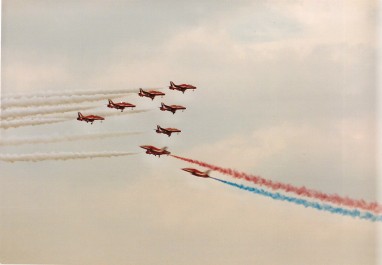“If you don’t like the Blue Angels, you don’t like America.” – A Facebook comment in response to a Seattle photographer’s misgivings regarding military demonstrations and recruitment tactics at Sea Fair.
After returning home from Iraq in 2004 I avoided crowded places. Concerts and festivals were out of the question – the throngs of people and loud noises kicked my fight/flight response into high gear. Sporting events and air shows were another no-go; flyovers from fighter jets after the national anthem once inspired in me a sense of awe and swelling patriotism – after my deployment, however, I was only reminded of war. The piercing roar of jet engines would cause my heart rate to skyrocket and a tightly coiled knot of anxiety and panic would gather at the base of my skull making every nerve ending in my body buzz.
But my post-deployment aversion to the fighter jet flyover wasn’t just rooted in the physiological response it provoked, but also in the underlying message: To be a patriot, one must love (and be in awe of) the Armed Forces.
The idea of the Blue Angels is, at its surface, a nice wholesome message of seemingly traditional Americana. Look at our technology! Look at our might! Look at the discipline and excellence of our Navy pilots!
And those pilots are tremendously skilled and disciplined – in operating equipment that is primarily designed to kill human beings.
Think about that.
Each time the Blue Angels (or any military fighter jets) fly in formation overhead, it is a demonstration of America’s capacity to kill. In connecting our feelings of patriotism with our admiration for the capabilities of the Department of Defense, we’re essentially conditioned to conflate one feeling with the other. And a major sporting event isn’t considered complete without a military fighter jet formation flyover to conclude our national anthem. Each time military fighter jets fly over the Super Bowl, the World Series, and thousands of other events across the country, it serves as a way to reinforce the connection between our national identity and our military supremacy.
So what? Isn’t military supremacy a part of our American heritage?
Yes, the US Military has been an integral part of US history (a history that was shamefully introduced with the genocide of Native Americans). But is employing the US war-making apparatus as central to our national identity actually a good thing? In the past we celebrated the return of our veterans from WWI and WWII and then helped them find their way back home with education and housing programs. As a nation, we began the work to right injustices that existed for people of color and women and those in poverty through numerous civil rights acts and social justice reforms. National protests brought our soldiers home from Vietnam. Our pride and heritage was centered on celebrating and bettering the lives of individual Americans.
Now the way we celebrate our country has morphed into a quasi-worship of the Armed Forces. “Support the troops” tropes have supplanted connections with actual veterans, and those Americans who question the value or need for increased defense budget allocations or preemptive military actions are in turn accused of lacking patriotism.
It’s a disturbing shift.
In much the same way US Military fighter jets have been incorporated into numerous American celebrations, at those same events the American flag is almost always carried out by service members or veterans, nameless and faceless in their uniformed number, merely a representation of the larger organization. Under the pretext of honoring veterans, the American flag is repeatedly associated with conflict and war. And at these events, are we really honoring the individuals who served? Do we learn about their favorite past times, their families, or their goals for the future? Almost always the answer is “no”. The Veteran or The Service Member is simply a placeholder meant to keep in the forefront of our minds the ever present connection between America and its fighting forces.
There are many other ways to celebrate the vast array of traditions and diversity in the United States without incorporating a demonstration of military power. Rather than watching nameless and faceless uniformed troops unfurl our colors at national sports events, imagine seeing elementary students or family members of the local team carry out our American flag. Perhaps instead of incorporating fighter jet flyovers after the national anthem, we could honor first-generation college graduates or recently naturalized American citizens.
While the US Military and American identity are connected historically, they aren’t inextricable. Celebrating our national heritage does not require that we also celebrate our ability to make war. Our national pride is not inseparable from our military might, and I argue that we will act as better Americans (and better plan for a peaceful future) if we do separate our national identity from our military capacity.

